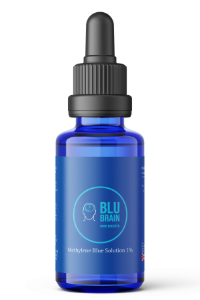Your basket is currently empty!

Despite methylene blue‘s compelling biochemical rationale—it enhances mitochondrial function, reduces oxidative stress, and dampens neuroinflammation—you’ll find its track record in ALS research disappointingly underwhelming.
The compound showed no survival benefit or motor improvement in SOD1(G93A) mouse models, the gold standard for preclinical ALS testing.
While simpler organisms, such as C. elegans, have demonstrated promising results, and methylene blue has proven neuroprotective effects in other conditions, the preclinical-to-clinical translation gap remains substantial.
Understanding why this mechanistically sound approach failed reveals critical insights about ALS therapeutic development.
Key Takeaways
- Methylene blue targets mitochondrial dysfunction and oxidative stress in ALS through multiple cellular pathways with established safety profiles.
- SOD1 mouse models demonstrated no survival benefit, motor improvement, or neuroprotection, highlighting significant gaps in preclinical-to-clinical translation.
- Simple organisms, such as C. elegans and zebrafish, demonstrated motor neuron protection and slowed paralysis with methylene blue treatment.
- Systemic administration failed to replicate benefits; local application shows more promise than systemic approaches in ALS contexts.
- Current clinical trials focus predominantly on Alzheimer’s disease, leaving ALS-specific therapeutic frameworks largely undeveloped and unexplored.
The Scientific Rationale: Why Researchers Thought Methylene Blue Could Work
When motor neurons degenerate in ALS, multiple cellular pathways collapse simultaneously—mitochondrial energy production fails, oxidative stress overwhelms antioxidant defences, and neuroinflammation accelerates tissue damage.
Methylene blue’s molecular mechanisms address each of these therapeutic targets specifically. The compound functions as an electron shuttle, bypassing the defective Complexes I and IV identified in the mitochondria of ALS patients.
You’ll find it inhibits nitric oxide synthase, counteracting the elevated nitric oxide production documented in all SOD1 familial mutations. This inhibition reduces microglial activation and the release of pro-inflammatory cytokines that drive disease progression in ALS models.
Methylene blue bypasses mitochondrial defects and inhibits nitric oxide synthase, directly targeting the molecular pathways that collapse in ALS neurodegeneration.
Methylene blue induces phase 2 antioxidant enzymes, including NADPH: quinone oxidoreductase 1 and selenoprotein thioredoxin reductase 1, which help maintain redox homeostasis against the elevated oxidative stress markers present in ALS patients.
These neuroprotective properties suggested that methylene blue could address multiple ALS pathological processes simultaneously. As a formal derivative of phenothiazine, the compound’s chemical structure enables it to possess unique electron transfer capabilities.
Its established safety profile in treating cyanide poisoning—another condition involving electron transport chain blockade—provided additional rationale for clinical investigation.
What Happened in Laboratory Mice: The Disappointing Reality
Despite its compelling molecular mechanisms, methylene blue failed thoroughly across multiple ALS mouse models tested by independent research teams. The disappointing outcomes revealed significant laboratory inconsistencies between theoretical promise and actual therapeutic efficacy.
Key findings from controlled studies:
- SOD1(G93A) mice showed zero survival benefit – Both 1 mg/kg and 10 mg/kg daily doses administered intraperitoneally from day 90 produced no lifespan extension, motor function improvement, or neuroprotection against motor neuron death.
- Pathological hallmarks remained unaffected – SOD1 protein aggregation, TDP-43 cytosolic mislocalisation, ubiquitination abnormalities, and neuroinflammation progressed identically in treated versus control groups across different transgenic models.
- Combination therapies and dosing variations failed – methylene blue plus lithium showed no synergistic effects. Meanwhile, different administration routes (oral, intraperitoneal) and treatment timing modifications produced minimal disease modification. Investigations using 2-photon laser-scanning microscopy did demonstrate that methylene blue could inhibit microglial reaction toward acute injury sites in the lateral column.
The preclinical-to-clinical translation gap proved insurmountable despite methylene blue’s established neuroprotective properties in other neurological conditions. These failures contrast sharply with methylene blue’s demonstrated ability to reduce lesion volumes and neuronal degeneration in traumatic brain injury models, highlighting disease-specific therapeutic limitations.
A Glimmer of Success in Simpler Organisms
The methylene blue story took an unexpected turn when researchers stepped back from complex mammalian systems to examine simpler model organisms.
C. elegans models expressing mutant human TDP-43 variants (A315T and G348C) demonstrated motor neuron degeneration and progressive paralysis—a pathology that methylene blue astonishingly reversed. These transparent nematodes allowed direct visualisation of neuronal health, with 60-100 animals per genotype providing statistical validity across repeated experiments.
The advantages of zebrafish became equally apparent when models expressing mutant TDP-43 and FUS proteins exhibited ALS-like motor dysfunction. Methylene blue prevented oxidative stress and improved locomotor defects, leveraging zebrafish‘s shorter reproductive cycles for efficient drug screening.
The compound suppressed toxicity from multiple variants—FUS S57Δ and R521H mutations responded similarly. Both organisms demonstrated preserved axonal integrity, slowed progression of paralysis, and restored motor phenotypes following treatment.
Notably, the treatment achieved these improvements without altering transgene expression levels, as confirmed through Western blotting analysis. The success in simpler organisms contrasted with the SOD1 G93A mouse model, where methylene blue failed to produce significant therapeutic effects on disease onset or survival despite its theoretical neuroprotective properties.
These platforms offered cheaper, faster, large-scale screening capabilities with highly conserved biochemical pathways relevant to human neurological systems.
Beyond ALS: Methylene Blue’s Proven Neuroprotective Effects
While ALS investigations sparked initial interest in methylene blue’s therapeutic potential, its neuroprotective capabilities extend across various neurological pathways with remarkable consistency.
You’ll find compelling evidence demonstrating methylene blue’s neuroprotective benefits across distinct conditions:
- Alzheimer’s and Parkinson’s Disease Models: Mitochondrial enhancement occurs through alternative electron transfer pathways, bypassing complexes I-III while reducing superoxide production and protecting HT-22 cells against glutamate, IAA, and rotenone toxicity.
- Traumatic Brain Injury and Stroke: Treatment reduces cerebral lesion volume by 30-40%, decreases Iba-1-positive microglial activation, and increases autophagy at perilesional areas through FDA-approved mechanisms.
- Human Clinical Applications: Controlled, randomised, double-blind studies demonstrate improved fear extinction memory and contextual memory functions. Post-session administration of methylene blue has shown behavioural improvements in claustrophobia and anxiety models, facilitating fear extinction and memory consolidation.
- Exercise-Induced Neurological Deficits: Intranasal administration provides neuroprotective effects against damage in critical brain regions, including the hippocampus and striatum, which play a crucial role in regulating learning, memory, and motor control.
Clinical outcomes include reversal of ifosfamide-induced encephalopathy and enhanced treatment responses in bipolar and unipolar depressive disorders.
These findings establish methylene blue’s consistent neuroprotective profile, which is attributed to its regenerable antioxidant properties that require NADH and mitochondrial reduction.
From Bench to Bedside: Why This Treatment Hasn’t Moved Forward
Methylene blue’s impressive neuroprotective profile across multiple conditions hasn’t translated into ALS therapeutic development, and the disconnect stems from fundamental limitations in preclinical efficacy.
In SOD1 G93A mouse studies, methylene blue delayed disease onset by approximately 10 days but provided no lifespan extension—the survival interval from symptom onset to death remained unchanged regardless of administration route or dosing regimen.
The translation barrier extends beyond modest efficacy to fundamental design flaws in treatment strategies. You’re witnessing clinical trials that don’t stratify patients by genetic background, despite ALS encompassing multiple causative genes encoding functionally varied proteins.
Microglia are activated in response to local CNS damage, with nitric oxide playing a crucial role in this inflammatory cascade that contributes to motor neuron death.
Clinical trials fail to account for ALS genetic heterogeneity, ignoring functionally distinct proteins encoded by different causative genes.
Systemic administration failed to reproduce the anti-inflammatory effects observed with local application, and benefits occurred primarily when treatment began at preclinical stages—an impossible timeline for human patients.
Current clinical trials focus mainly on Alzheimer’s disease rather than motor neuron applications, leaving ALS-specific therapeutic frameworks undeveloped and regulatory pathways unexplored.
Frequently Asked Questions
What Is the Recommended Methylene Blue Dosage for ALS Patients?
There’s no established recommended dosage for ALS patients, as no completed clinical trials exist specifically testing methylene blue in this population.
While methylene blue mechanisms targeting mitochondrial dysfunction show theoretical promise, preclinical studies haven’t identified effective doses.
Dosage considerations from Alzheimer’s trials (30-138 mg/day) can’t be extrapolated to ALS without safety studies.
You shouldn’t use methylene blue for ALS outside controlled research settings, given the absence of efficacy data and undefined therapeutic dosing parameters.
Can Methylene Blue Be Safely Combined With Existing ALS Medications?
You’ll find virtually zero published data on drug interactions between methylene blue and standard ALS treatment protocols like riluzole or edaravone.
While methylene blue’s electron transport mechanisms theoretically complement existing neuroprotective agents, no controlled studies have systematically evaluated the safety profiles of combination therapies.
You shouldn’t combine therapies without physician oversight, as methylene blue’s monoamine oxidase inhibition could interact with serotonergic medications.
Formal pharmacokinetic studies remain critically needed before establishing evidence-based combination treatment protocols.
Are There Any Ongoing Clinical Trials Testing Methylene Blue for ALS?
You won’t find ongoing clinical trials testing methylene blue specifically for ALS.
Current Methylene Blue Research focuses primarily on Alzheimer’s disease and ageing-related conditions, not motor neuron disease.
While preclinical studies demonstrated a reduction in TDP-43 aggregation, they failed to show improvements in motor function in ALS mouse models.
This gap between laboratory findings and clinical implementation means ALS Treatment Innovations currently pursues alternative therapeutic approaches rather than methylene blue trials.
How Much Does Methylene Blue Treatment Cost Compared to Approved ALS Drugs?
Treatment affordability data for methylene blue in ALS remains unavailable since no FDA-approved protocols exist.
However, a cost comparison suggests that methylene blue’s generic status could offer significant savings compared to edaravone (Radicava), which requires expensive IV infusions.
You’ll find that methylene blue’s established manufacturing infrastructure can potentially reduce production costs, although clinical trial expenses and regulatory approval requirements will substantially impact the final treatment pricing.
Current off-label use lacks standardised dosing protocols, affecting accurate cost assessment.
What Are the Common Side Effects of Methylene Blue in Humans?
You’ll notice methylene blue’s most distinctive side effect immediately—bluish-green urine discolouration.
Common reactions include skin discolouration, headaches, nausea, and altered taste sensation. You might experience injection site pain, dizziness, or gastrointestinal symptoms.
Serious side effects warrant immediate attention: serotonin syndrome when combined with antidepressants, hemolytic anemia (especially with G6PD deficiency), and severe allergic reactions.
Dosage directly correlates with symptom severity, requiring careful monitoring throughout treatment.
Conclusion
You’ll find methylene blue’s journey in ALS research resembles a promising seedling that withered before bearing fruit. While its mitochondrial enhancement mechanisms demonstrated neuroprotective efficacy in certain paradigms, the compound failed to translate therapeutic benefit in mammalian ALS models.
You’re left with a compelling preclinical rationale, but it is undermined by inadequate clinical translatability.
Until rigorous phase II trials demonstrate disease modification through validated biomarkers and functional outcomes, methylene blue remains an unproven intervention despite its established pharmacological properties in other neurodegenerative contexts.

